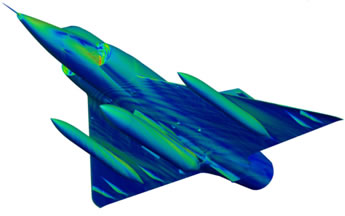Through an original mathematical formulation, ONERA has achieved spectacular gains in the calculation of ERS and is ranked among the best in the world in relation to this problem
Radars detect and even identify aircraft at a long distance, because the latter reflect some of the electromagnetic waves received. Each plane in fact has its own radar signature - the ERS (Equivalent Radar Signature). The ability to anticipate this signature by simulation is decisive, both for the design and for when it comes to identifying a non-cooperative target.
Maxwell's equations, which describe the behavior of electromagnetic waves and in particular their reflection, show that a plane behaves like a set of antennas of the size of the radar beam wavelength. To represent an aircraft measuring several meters, it is thus necessary to resort to millions of "antennas" that measure a few centimeters, which emit and interact with each other.

Numerical simulation of surface currents on a Mirage III subjected to a 4GHz EM wave. Calculation for 5 million antennas in 4.5 hours on a Xeon uniprocessor
In early 2012, spectacular performance gains were achieved by means of an original ONERA mathematical formulation based on this approach. The new method was tested for the calculation of a weapon aircraft with payload and details and resulted in a gain with a factor of 22 in the overall time for calculating the ERS, compared to conventional methods. ONERA is one of the best players in the world in regard to this problem.




